Hello and welcome! In this guide, I’ll be sharing important information about natural fruit juice without added sugar. Nowadays, many people are seeking healthier alternatives to sugary beverages. If you’re one of them, you’re in the right place!
Fruit juice and smoothies can contain naturally occurring sugars called fructose, which contribute to our intake of free (added) sugars. However, whole fruit doesn’t add to our intake of free sugar. It’s important to be aware of hidden sugars in foods and cut down where possible.
While it’s generally recommended to consume whole fruit instead of fruit juice or smoothies, I understand that you might still want to enjoy these beverages occasionally. Don’t worry, I have some tips for you!
Keep reading to learn more about the difference between fructose and added sugar, the impact of sugar on health and disease, the importance of whole fruit in a healthy diet, and guidelines for consuming fruit juice and smoothies.
Remember, knowledge is power when it comes to making informed choices about your diet. Let’s dive in and discover the world of natural fruit juice without added sugar!
Key Takeaways:
- Whole fruit doesn’t contribute to your intake of free (added) sugar.
- Too much free sugar can lead to obesity, tooth decay, and the risk of Type 2 diabetes.
- Whole fruit is a rich source of fiber, vitamins, and minerals.
- If you choose to consume fruit juice or smoothies, limit the quantity and dilute it with water.
- Be mindful of hidden sugars in foods and read ingredient lists carefully.
Understanding the Difference Between Fructose and Added Sugar
When it comes to sugar, it’s important to understand the difference between fructose and added sugar. Fructose is a naturally occurring sugar found in fruits, fruit juices, and smoothies. It is a simple sugar that gives fruits their natural sweetness.
Whole fruits contain fructose, but they do not contribute to your intake of free (added) sugar. This is because the fructose in whole fruits is accompanied by fiber, which helps to slow down its absorption into the bloodstream. Eating whole fruits provides essential nutrients, vitamins, and minerals along with the natural sugar they contain.
On the other hand, fruit juices and smoothies can contain added sugar. Added sugar refers to sugars that are added to foods by manufacturers. Fruit juices and smoothies often have added sugars to enhance the taste or prolong shelf life.
“It’s important to be aware of the intake of free (added) sugars in your diet. High consumption of added sugar has been linked to health issues such as obesity, tooth decay, and an increased risk of Type 2 diabetes.”
By understanding the difference between fructose and added sugar, you can make more informed choices about your sugar consumption. Remember that it’s always better to opt for whole fruits over fruit juices and smoothies to get the benefits of fiber and the natural sugars found in fruits.
The Impact of Sugar on Health and Disease
Consuming too much free (added) sugar can have detrimental effects on our health, leading to obesity, tooth decay, and an increased risk of Type 2 diabetes. It is important to be mindful of our sugar intake and make conscious efforts to reduce it in order to maintain optimal health.
“Excessive sugar consumption is a major contributor to the rising obesity rates and associated health issues.”
The Scientific Advisory Committee on Nutrition recommends limiting our intake of free (added) sugars to no more than 5% of our total daily energy. This translates to a maximum daily intake of 19g for children aged 4 to 7, 24g for children aged 7 to 10, and 30g for children over 11 and adults. By reducing our sugar intake, we can reduce the risk of developing various health conditions associated with excessive sugar consumption.
Obesity is a significant concern linked to high sugar intake, as it provides excess calories without proper nutrition. The body converts excess sugar into fat, leading to weight gain and an increased risk of obesity-related diseases such as heart disease and certain types of cancer.
Furthermore, sugary foods and beverages contribute to tooth decay. The bacteria in our mouths feed on sugar, producing acids that erode tooth enamel and lead to cavities. Limiting our sugar intake can help protect our teeth and promote good oral health.
“High sugar intake is a known risk factor for developing Type 2 diabetes.”
Type 2 diabetes, a chronic condition characterized by high blood sugar levels, is strongly associated with excessive sugar consumption. The body’s ability to properly regulate blood sugar is affected by frequent spikes caused by consuming sugary foods and drinks. By reducing our sugar intake, we can help manage and prevent the onset of Type 2 diabetes.
The Impact of Sugar on Health and Disease:
| Health issues | Effects |
|---|---|
| Obesity | Increased risk due to excess calorie intake |
| Tooth decay | Cavities and dental problems caused by the breakdown of sugar by oral bacteria |
| Type 2 diabetes | Elevated blood sugar levels and reduced insulin sensitivity |
The Importance of Whole Fruit in a Healthy Diet
When it comes to maintaining a healthy diet, whole fruit plays a crucial role. Not only is it delicious and refreshing, but it also provides essential nutrients that are beneficial for overall health. Whole fruit is a rich source of fiber, vitamins, and minerals, making it a wholesome choice for your daily intake.
Fiber: One of the key benefits of whole fruit is its high fiber content. Fiber is essential for proper digestion and can help regulate blood sugar levels. It also promotes a feeling of fullness and can assist in weight management. By including whole fruit in your diet, you can ensure a healthy dose of fiber that keeps your digestive system functioning optimally.
Vitamins and Minerals: Whole fruit is packed with an array of vitamins and minerals that are essential for various bodily functions. These nutrients contribute to a strong immune system, healthy skin, and improved overall well-being. Incorporating a variety of whole fruits into your diet ensures a diverse range of vitamins and minerals that are vital for maintaining optimal health.
When comparing whole fruit to fruit juice or smoothies, it’s important to note that the latter often have the fiber content removed and can be higher in calories, carbs, and sugar. By opting for whole fruit, you not only benefit from its nutritional value but also prevent excessive calorie and sugar consumption. Note: When consuming whole fruit, it’s essential to be mindful of serving sizes to avoid overeating.
To visually highlight the importance of whole fruit in a healthy diet, here is a table showcasing the fiber, vitamin, and mineral content of various popular fruits:
| Fruit | Fiber (g) | Vitamin C (mg) | Potassium (mg) |
|---|---|---|---|
| Apple | 2.4 | 8.4 | 195 |
| Banana | 3.1 | 8.7 | 422 |
| Orange | 4.4 | 70 | 233 |
| Strawberries | 2 | 54 | 153 |
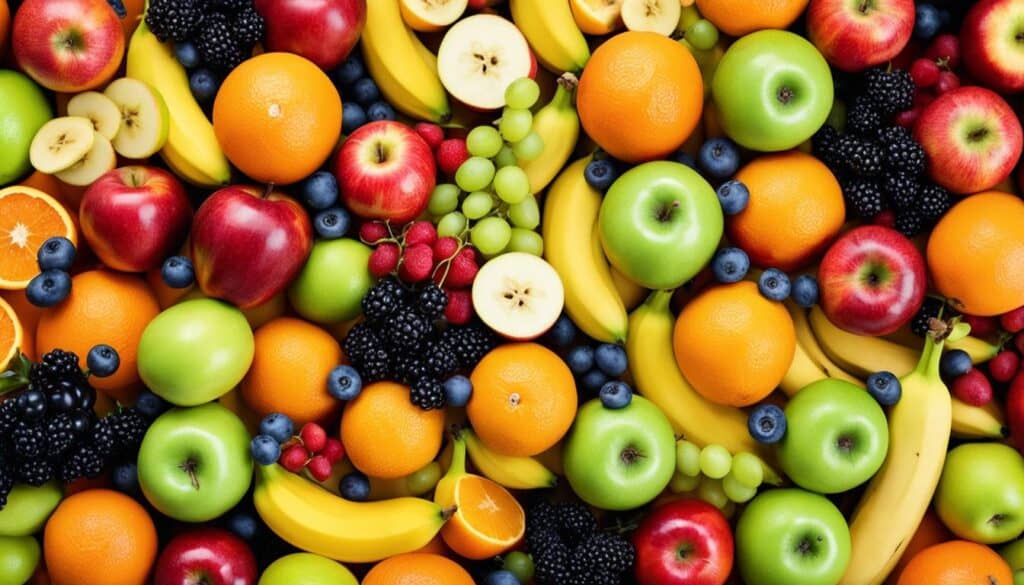
By incorporating a variety of whole fruits into your daily meals and snacks, you can reap the benefits of fiber, vitamins, and minerals that contribute to a healthy diet. Remember, whole fruit should be enjoyed alongside a balanced eating plan that includes a variety of food groups, ensuring you receive a well-rounded intake of nutrients.
Guidelines for Consuming Fruit Juice and Smoothies
While whole fruit is preferable, consuming fruit juice or smoothies can still be a part of a healthy diet when done in moderation. Here are some guidelines to follow when enjoying these beverages:
Limit portion size: It is recommended to consume no more than 1 small glass of fruit juice or smoothie per day, equivalent to 150ml. This helps to control the intake of sugar and calories.
Dilute with water: To further reduce sugar and calorie intake, consider diluting your fruit juice or smoothie with water. This can help to make the portion size go further and lower the overall sugar content.
Be mindful of carbohydrate intake: Fruit juice and smoothies can have a significant impact on blood sugar levels due to their carbohydrate content. Consider adjusting your carbohydrate intake from other sources, such as bread, to accommodate the extra carbs from fruit juice or smoothies.
Opt for homemade smoothies: If possible, prepare your own fruit smoothies at home using whole fruits. This way, you can include the fiber from the fruits and have better control over the ingredients, ensuring no additional sugar is added.
By following these guidelines, you can enjoy fruit juice and smoothies while maintaining a balanced and mindful approach to your carbohydrate and sugar intake.
| Fruit Juice Comparison | Carbohydrate Content (per 100ml) | Sugar Content (per 100ml) | Calorie Content (per 100ml) |
|---|---|---|---|
| Orange Juice | 8.4g | 8.4g | 45 |
| Apple Juice | 10g | 9.8g | 46 |
| Tomato Juice | 3.7g | 2.6g | 17 |
Note: The values above are approximate and may vary depending on the brand.
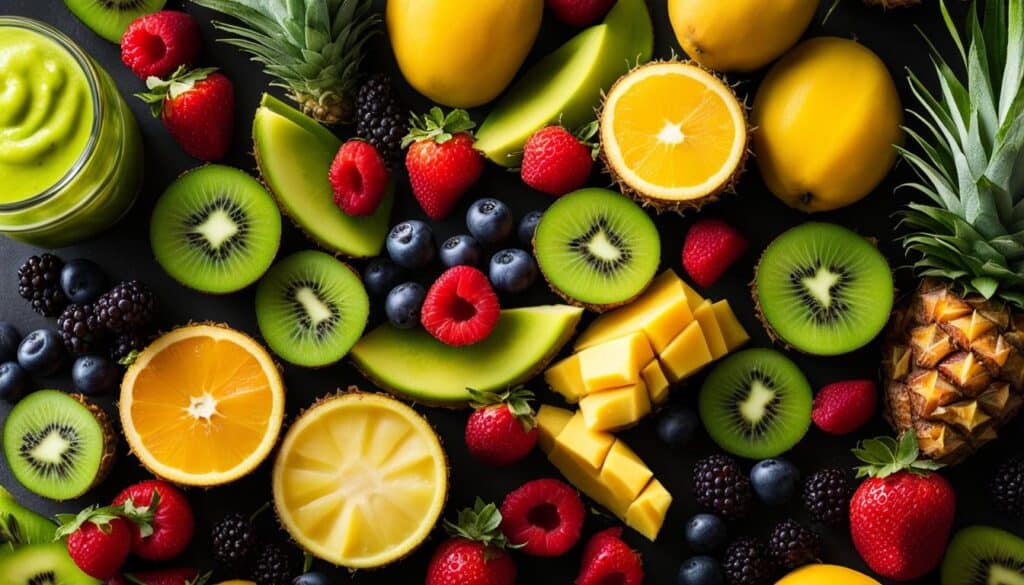
Visualizing and comparing the carbohydrate, sugar, and calorie content of different fruit juices can help you make informed choices about your beverage consumption.
The Myth of Completely Avoiding Sugar
When it comes to sugar intake, it’s a common misconception that we should completely avoid it. While it’s true that cutting down on the intake of free (added) sugar is essential for a healthy diet, eliminating sugar altogether is unnecessary.
One area where this myth often leads to confusion is in the context of the “five-a-day” target for fruit and vegetable consumption. It’s important to note that the sugar present in whole fruit is not included when considering sugar intake. So, enjoying whole fruit as part of your five-a-day doesn’t mean you’re consuming excessive sugar.
In fact, including whole fruit in your diet is essential for your overall health. Whole fruit is packed with essential nutrients, including fiber, vitamins, and minerals, that can help protect against stroke, heart disease, and certain cancers. It’s a natural and wholesome source of nutrition that shouldn’t be avoided.
To illustrate the importance of including whole fruit, here is a table comparing the sugar content and nutritional benefits of whole fruit versus fruit juice:
| Whole Fruit (per 100g) | Fruit Juice (per 100ml) |
|---|---|
| Low in sugar | High in sugar |
| Contains fiber, vitamins, and minerals | Fiber is often removed, lower in vitamins and minerals |
| Can help you feel fuller for longer | High in calories, carbs, and sugar |
Table: Comparison of Sugar Content and Nutritional Benefits of Whole Fruit and Fruit Juice
As you can see, whole fruit is a more balanced and nutritious choice compared to fruit juice. By enjoying whole fruit as part of your five-a-day, you can satisfy your sweet cravings while nourishing your body with essential nutrients.
So, instead of completely avoiding sugar, focus on reducing the intake of free (added) sugar and being mindful of hidden sugars in processed foods. Embrace the natural sweetness of whole fruit and make it a regular part of your healthy eating plan.
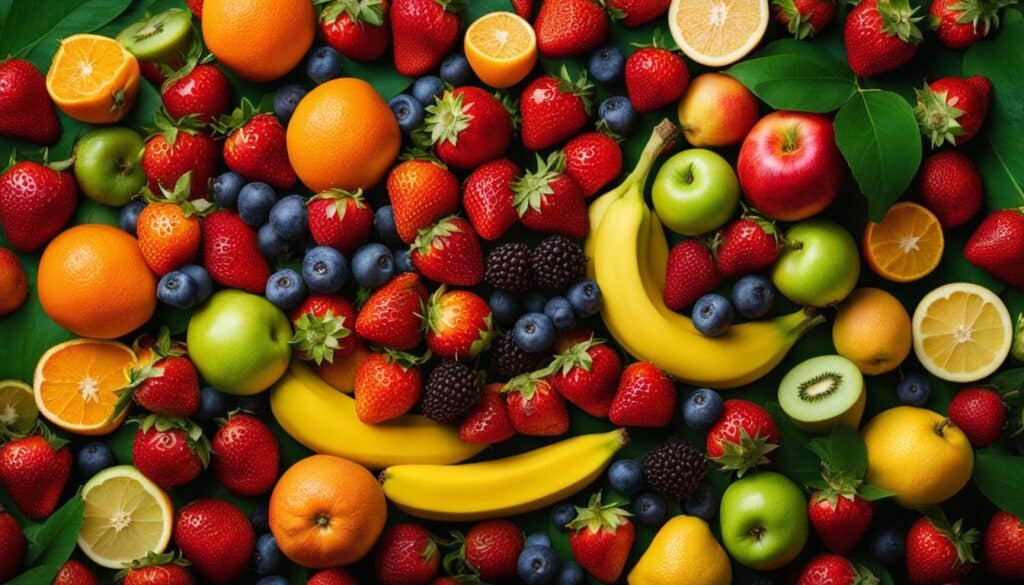
The Sneaky Ways Sugar is Hiding in Foods
Added sugar can be found in various forms and hidden in many foods. It’s important to read ingredient lists and be aware of the different names of sugars used, such as words ending in “ose” and various syrups and nectars. Hidden sugars can contribute to the intake of free (added) sugars, which should be limited to maintain a healthy diet.
Here are some common hidden sugars to watch out for:
- Dextrose
- Fructose
- Glucose
- Lactose
- Maltose
- High fructose corn syrup
- Corn syrup
- Maple syrup
- Honey
- Agave nectar
These sugars can be found in a wide range of products, including:
- Sauces and dressings
- Baked goods
- Granola bars
- Yogurts
- Flavored drinks
- Cereals
Always check the ingredient lists carefully to identify added sugars. It’s important to be mindful of the sugar content in foods, even those that may seem healthy on the surface.
Remember, just because a food is labeled as “healthy” or “natural,” it doesn’t mean it’s free from added sugars. Always double-check the ingredient lists to make informed choices.
Food labels will soon include information on added sugars to make it easier for consumers to identify and track their intake. This is a positive step towards promoting sugar awareness and enabling individuals to make healthier choices. Keep an eye out for these labels and use them as a tool to guide your purchasing decisions.
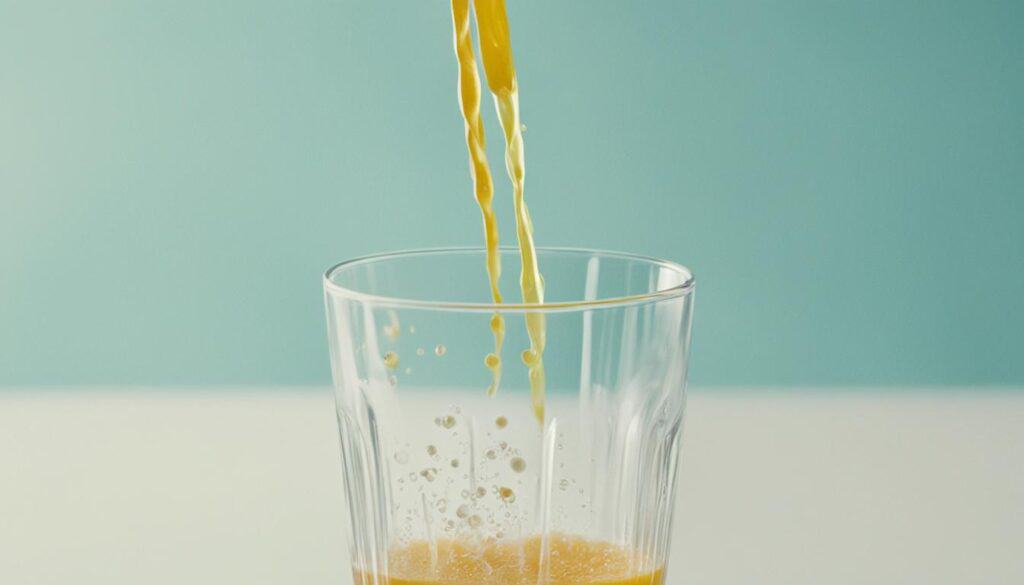
Being aware of hidden sugars and actively monitoring your sugar intake is essential for maintaining a balanced and healthy diet. By understanding the different names for added sugars and carefully reading ingredient lists, you can make more informed choices while grocery shopping and optimize your overall health.
Debunking Misleading Sugar Claims
The labels “no added sugar” and “no refined sugars” can be misleading, as they often do not accurately reflect the true sugar content of a product. While these claims may imply that the product is free from any form of sugar, it is important to be aware that fruit juices and other concentrated fruit sugars can still be added to provide sweetness.
It’s also worth noting that alternative sweeteners such as honey, agave nectar, and maple syrup, while perceived as healthier alternatives, are still forms of sugar and can contribute to overall sugar intake.
Another aspect to consider is the use of sugar alcohols in various products. Sugar alcohols, although naturally occurring, are not calorie-free and can have gastrointestinal side effects if consumed in excess. It’s essential to read food labels carefully and not be swayed by claims that may misrepresent the actual sugar content in a product.
Myth Busted: “No added sugar” doesn’t mean sugar-free
“No added sugar” claims may give the impression that a product is completely free of sugar, but it’s important to look beyond the claim and examine the ingredient list and nutritional information to determine the true sugar content.”
Understanding Sugar Alcohols
Sugar alcohols, such as erythritol, xylitol, and sorbitol, are commonly used as sweeteners in sugar-free or reduced-sugar products. While they may provide a sweet taste without raising blood sugar levels as much as regular sugar does, they still contain calories and may have a laxative effect if consumed in large quantities.
“Sugar alcohols can be a useful tool in reducing overall sugar intake, but it’s important to consume them in moderation and be aware of their potential effects on digestion.”
To make informed choices, always review the ingredient list and nutritional information of products before purchase. Don’t solely rely on claims like “no added sugar” or “no refined sugars.” Instead, prioritize a balanced diet that includes whole foods, limits refined sugars, and promotes mindful consumption of all sugar sources.
Remember, being aware of misleading sugar claims can help you make more informed decisions about your health and well-being.
| No Added Sugar | No Refined Sugars | Sugar Alcohols | |
|---|---|---|---|
| Definition | A claim indicating that no additional sugar has been added to the product during the manufacturing process. | A claim suggesting that the product does not contain any refined or processed sugars. | Sweeteners derived from plant sources that have fewer calories compared to regular sugar. |
| Likely Ingredients | Fruits, fruit juices, or other concentrated fruit sugars. | Alternative sweeteners like honey, agave nectar, or maple syrup. | Erythritol, xylitol, sorbitol, and other sugar alcohols. |
| Calorie Content | May still contribute to calorie intake depending on the ingredients used. | Alternative sweeteners contain calories and may contribute to overall calorie intake. | Sugar alcohols contain calories, but fewer calories compared to regular sugar. |
| Possible Side Effects | None | None | Possible gastrointestinal side effects if consumed in excess. |
Conclusion
Being mindful of our sugar intake is essential for maintaining a healthy diet. While whole fruit is the preferred choice over fruit juice or smoothies, it is still possible to enjoy these beverages in moderation. By reading food labels, understanding ingredient lists, and being aware of hidden sugars in foods, we can make informed choices about what we consume.
It is important to develop overall healthy eating habits that prioritize balanced nutrition and mindful consumption, rather than completely avoiding sugar. A healthy diet involves incorporating a variety of fruits, vegetables, whole grains, lean proteins, and healthy fats while limiting the intake of added sugars and processed foods.
By being aware of the impact of sugar on our health and following recommended guidelines for consumption, we can maintain a well-rounded diet that supports our overall well-being. With a focus on healthy eating, sugar awareness, and mindful consumption, we can make positive choices that contribute to a healthier lifestyle.
FAQ
Is fruit juice without added sugar healthier than regular fruit juice?
Yes, fruit juice without added sugar is a healthier option. Regular fruit juice can contain high amounts of free (added) sugars, while fruit juice without added sugar is made from 100% fruit and does not have any additional sugars.
Can I still consume fruit juice if I want to reduce my sugar intake?
While it is better to eat whole fruit, if you still want to consume fruit juice, it is recommended to limit the quantity to 1 small glass a day (150ml) and dilute it with water to reduce sugar and calorie intake.
Why is it recommended to eat whole fruit instead of drinking fruit juice or smoothies?
Whole fruit contains fiber, vitamins, and minerals that are beneficial for overall health. Fruit juice and smoothies often have most of the fiber removed and can be high in calories, carbs, and sugar.
How much free (added) sugar can I consume per day?
The recommended limit is no more than 5% of our energy coming from free sugar. This translates to a maximum daily intake of 19g for children aged 4 to 7, 24g for children aged 7 to 10, and 30g for children over 11 and adults.
What are the health risks associated with consuming too much free (added) sugar?
Consuming too much free (added) sugar can contribute to obesity, tooth decay, and the risk of Type 2 diabetes.
How can I identify hidden sugars in foods?
It is important to read ingredient lists and be aware of the different names of sugars used, such as words ending in “ose” and various syrups and nectars. Food labels will soon include information on added sugars to make it easier for consumers to identify and track their intake.
Are products labeled “no added sugar” completely free of sugar?
No, products labeled “no added sugar” can still contain fruit juices or other forms of concentrated fruit sugars to sweeten taste. It is important to read food labels carefully and not be swayed by claims that may misrepresent the sugar content in a product.
Do natural sweeteners like honey and agave syrup count as added sugars?
Yes, honey, agave nectar, and other natural sweeteners are still forms of sugar and are not necessarily healthier alternatives. They should still be consumed in moderation.
Is it necessary to completely avoid sugar in my diet?
It is not necessary to completely avoid sugar, but it is important to cut down on the intake of free (added) sugar. Whole fruit should be included as part of a healthy eating plan to provide essential nutrients and protect against certain diseases.

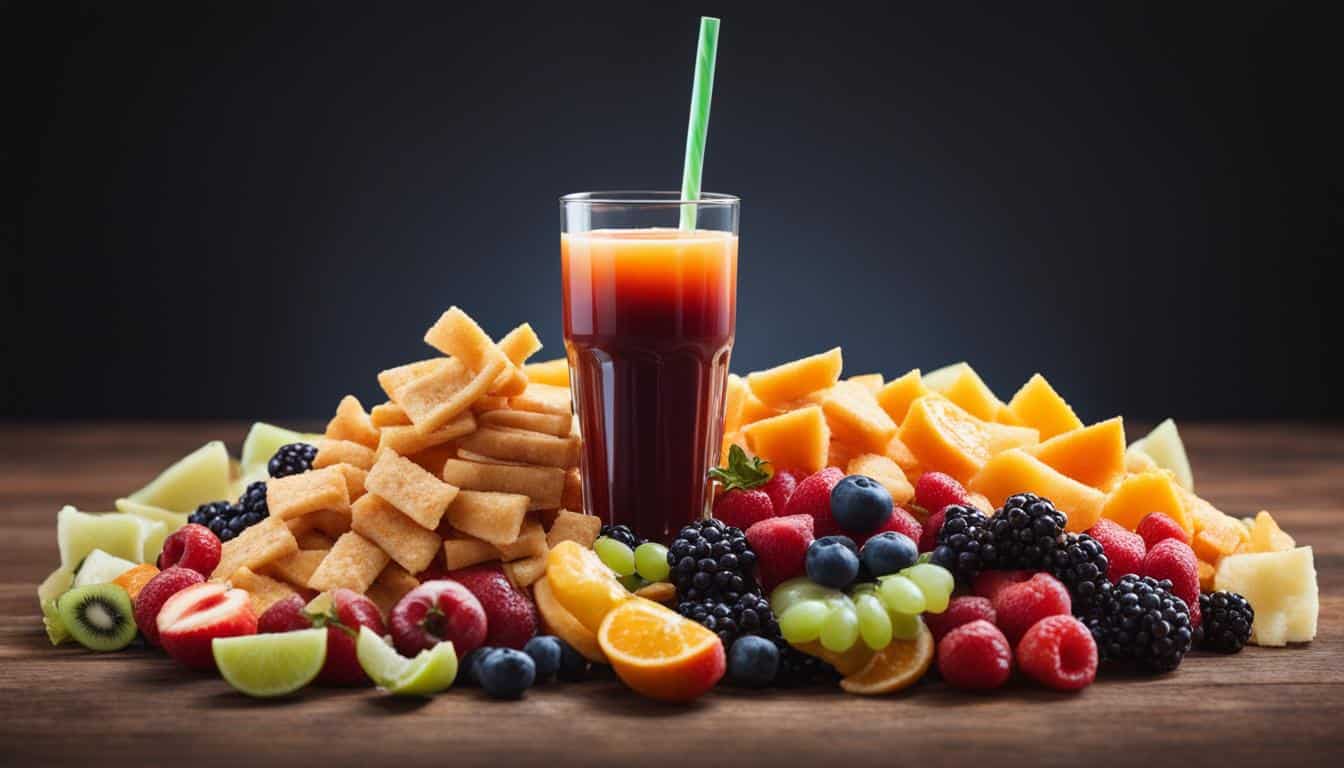



Leave a Reply